
I’ve got a rare treasure for you this week – a previously lost wartime cartoon by Ted Eshbaugh. But first, I thought it would be kind-of cool to show how a typical telecine transfer is done – and happily, Mary (my other half) came along and did some photos for this week’s post. Thanks Mary!
I always look forward to the telecine transfer sessions, though always with trepidation. The exciting thing is you often don’t know exactly what you’re going to see, and moreover, how good it will or won’t look. Most of my local
transfer sessions are done by Motion Picture Transfer, a company run by expert Telecine operator and colorist Pat Mathews. When you see good results on some of the Thunderbean material, Pat gets the first credit for his excellent eye (and for putting up with my fussiness in trying to make them look as good as possible). He’s similar to me in that he always wants it to look better… and can often do wonders.
When you step into the studio, you know you’re spending money (billed for the time it takes rather than the actual footage) so that’s the part I’m really trepidatious about. It isn’t that I’m a cheapskate- I love great results, but I never have am endless Dreamworks budget of course- in fact, more has been spent on Madagascar 3‘s font types than the budget for a typical Thunderbean DVD, but things are looking up! They’re mostly funded by the DVD sales. Gulliver is doing ok (and I think Technicolor Dreams will too) so there will be more Blu-rays. Sometimes I can spend the time in Telecine to make it look great there; often I end up having to do a straight transfer and Pat has to sit on his hands a little. Still, we end up with great results.
It was hard to schedule this week, and I ended up having to finish the first batch of prepping in the morning just before the transfer. There was a whole series of cool things to do this week, from silent cartoons to outtakes from Lou Bunin’s Bury the Axis (more on this and the Bunin project in the coming weeks). I’ve been soaking two 16mm silent films in cleaner to soften them, but those two still are not ready sadly.
Here is the Shadow Telecine, a great machine to do HD transfers with. This is a line array scanner that captures 35mm and 16mm film.
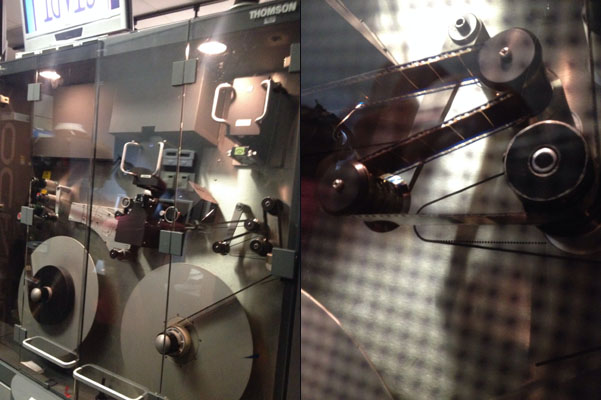
Two of my animation students from The College for Creative Studies, Lauren Schmidt and Sammi Kerwin, are helping with the Lou Bunin project. They came along to see the first glimpse of some footage shot 70 years ago and likely not seen since. Here we’re looking at some Nitrate that we decided not to run in this session.
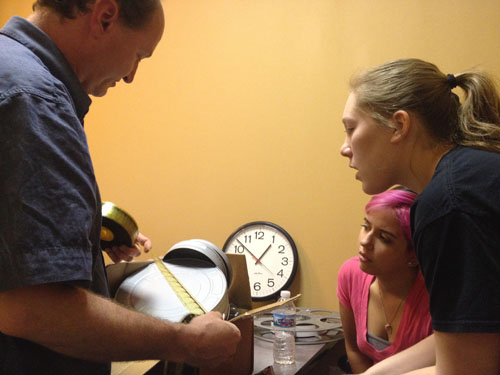
Winding a film onto a core so the tension is good for the Telecine….

..and showing how to identify IB Technicolor film…
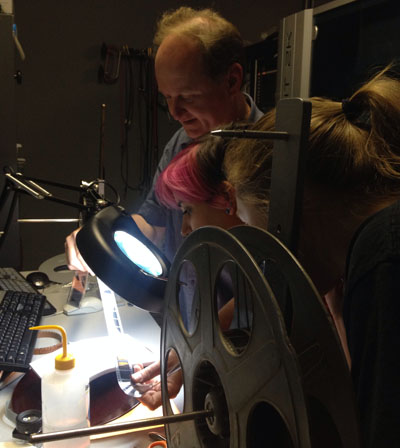
Pat threads up the Telecine….

…..you sometimes don’t know if a print is wound correctly, or backwards!

Pat zooms up on the picture to get the best possible focus…
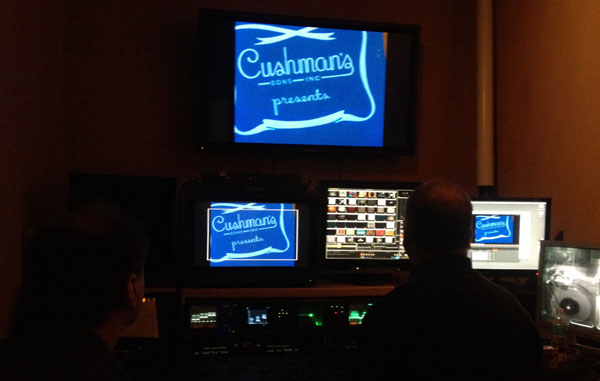
The edit room is a hike down the hall from the Telecine. It’s close quarters, but usually only occupied by a few people.
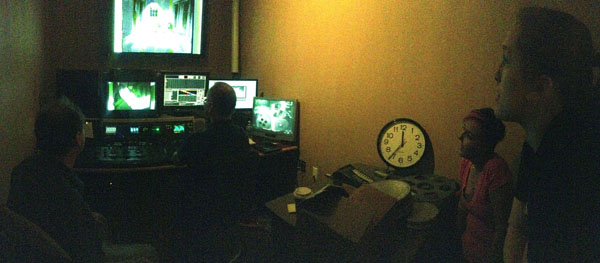
When everything is finally all set up and color adjusted, it’s finally layed out to a digital file. We used to always run everything to tape, but these days it’s a digital quicktime. All sorts of things were transferred for all different projects.



This was a particularly great session with lots of rare material. One of the great finds is this week’s cartoon, Sammy Salvage, made by Ted Eshbaugh for the Conservation Division of the War Production Board. I had wanted to see this for almost 30 years. Here it is, transferred on Tuesday from a 35mm IB Techncolor Nitrate print. I hope to have this on a future release sometime soon! Have a good week everyone!


 Steve Stanchfield is an animator, educator and film archivist. He runs Thunderbean Animation, an animation studio in Ann Arbor, Michigan and has compiled over a dozen archival animation DVD collections devoted to such subjects at Private Snafu, The Little King and the infamous Cubby Bear. Steve is also a professor at the College for Creative Studies in Detroit.
Steve Stanchfield is an animator, educator and film archivist. He runs Thunderbean Animation, an animation studio in Ann Arbor, Michigan and has compiled over a dozen archival animation DVD collections devoted to such subjects at Private Snafu, The Little King and the infamous Cubby Bear. Steve is also a professor at the College for Creative Studies in Detroit.






















little sam uses his magic flute to bring junk to life, and then leads the living junk to a horrible fiery death.
I sometimes wish I could ask people involved with things like this what they were thinking. further, with so many hands involved in the production of animated films, it’s difficult to understand how flaws in logic like this slip through the proverbial cracks.
I think a better idea would have been for little sam to use his flute to get children to follow him with their arms and wagons filled with junk.
Hate to say I didn’t think that way about this film at all (perhaps because I still viewed the junk as inanimate objects otherwise being brought to life by this person’s magical flute. In that kind of context they really wouldn’t have much a life as sentient junk people if that was the thought behind making this piece.
Of course if you had to think of a more unusual film also surrounding the same things, Halas & Batchelor over in England put out this piece on saving bones along with other scrap.
https://www.youtube.com/watch?v=mSHQdmWP3S0
I’m pretty sure even animated iron doesn’t feel pain, and being reforged wouldn’t hurt any more than being forged in the first place. Think of it as “rebirth,” where instead of rotting away in an attic or a dump, junk gets another chance to be useful.
I agree that there’s more than a little that’s creepy about this, especially now, looking back at 1943, when towns all over Europe were “getting rid” of those who were “unwanted” and who were then being marched away into a “furnace.”
Love the film!! Beautiful Technicolor! Thanks Steve!
Ohhhhh, my sweet GOD!! And me who goes crazy for WWII toons. (But had NEVER seen this!) A drop-dead gorgeous little film….espesh after its refurbishments. Thank YOU!!
Steve, the SAMMY film looks fabulous!!!! Yes, the transfer is wonderful, and the source material is dazzling… but, damn, what a great little film! Love all those little junk creatures marching into the blast furnace. And that peach label gag… wow!
And that peach label gag… wow!
I see I wasn’t the only one to notice that! That was perfect!
Awesome! Great to get a behind-the-scenes look at Thunderbean. That announcer near the end of “Salvage Sammy” sounded like Thurl Ravenscroft.
I agree, that does sound like a young Thurl! – W.
Thanks Steve, beautiful transfer!
This cartoon is good enough to make an Eshbaugh fan out of me, haha. One of the most impressive of the few I’ve been able to see (most of them courtesy of you).
If nothing else, I suddenly feel better about my own personal recycling effort.
Wow! what a great find, and such beautiful print. Thanks for sharing and thanks for all your great efforts in preserving these treasures.
Steve:
I’m also seeing this for the first time! The design of the junk people is very creative! It’s too bad there isn’t more Eshbaugh product available!
Loved the film and, wow, it would be nice to have it on a future Thunderbean project. So, forgive my ignorance, but is a telecine the digital equivalent of a movieola? If so, then I guess this is the way of “cleaning up” the image, frame by frame, for a future DVD release. I’m also guessing that even Warner Bros. used this method for the LOONEY TUNES GOLDEN COLLECTION and TOM & JERRY GOLDEN COLLECTION sets.
Love that rhyme in the song:
Take a tip from uncle
junk’ll
win the war.
Thanks, Steve – became a big fan of Eshbaugh’s work the first time I saw THE SUNSHINE MAKERS.
Great work Steve! Hope to see this released soon!
Marvelous! And thanks for the behind the scenes look at all the work that goes into your great projects. I’m always looking forward to more Thunderbean releases. Now all I need is to win the lottery so I can buy them all. 😉
Ben Harrison wasn’t the only cartoon director who liked parades of odd characters, practically this whole little cartoon is a parade of odd junkyard critters! I’ve often wondered how many old cels, drawings, acetate recordings of rare radio shows of the 1930s and other precious pop cultural and cartoon artifacts were sacrificed to the scrap drives of World War 2?
Record companies contributed many of the metal parts in their vaults to World War II scrap drives, generally alternate takes and unissued masters that were deemed too old to have commercial value.
Quite a mixture of styles, the first half like a throwback to the Silly Symphonies/Fleischer Color Classics, then, as the junk marches into the furnace, there’s a brief shot of machinery whose riot of colors and near-abstract shapes could almost come from a mid-century modern/UPA industrial short. After that, we’re in Fleischer/Famous Superman land.
A nice cartoon to see on this, the anniversary of D-Day. I can take an old pot going to the smelter, but I would have shed a tear if they’d shown old Superman comic books being thrown into a shredder after a paper drive.
GREAT!
What a GREAT find! Thank you!!
This was fantastic. I great piece of history…..
Sure,..I could see where perhaps they could have simply shown a side profile silhouette of a furnace and then maybe have the junk pieces exiting the furnace as shiny new pieces of weaponry,…but hey,…it was a different time then and one must first understand that the PC Police had not entered the scene yet.
For what it is and what it represents,..this is a wonderful piece of history and very well done.